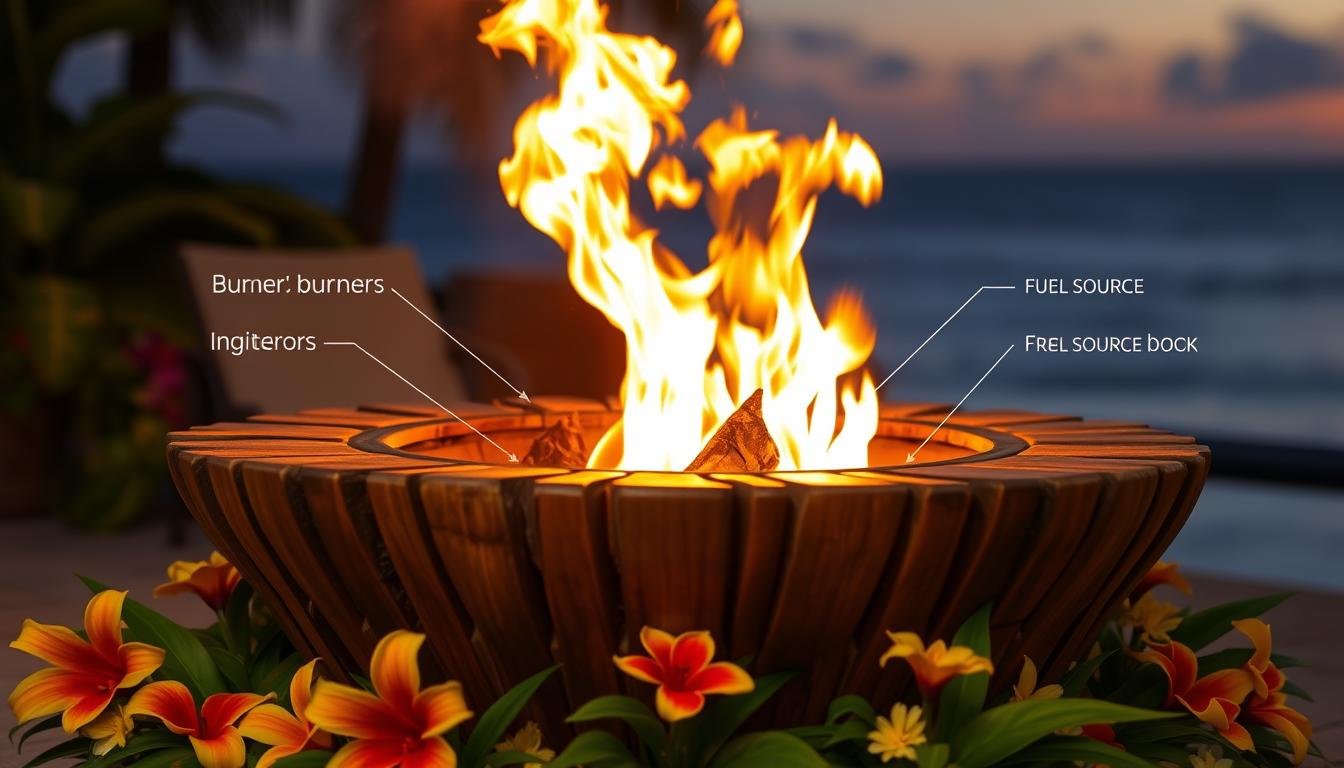A well-maintained fire pit is not only a safe and enjoyable feature in your outdoor space, but it also ensures optimal performance and longevity.
Proper care and regular maintenance can prevent expensive repairs and extend the life of your fire pit.

This comprehensive guide covers all aspects of fire pit care, from routine cleaning to seasonal maintenance tips, to help you keep your outdoor feature in top condition.
By following the expert advice outlined in this guide, you’ll be able to enjoy your fire feature for years to come, while ensuring it remains a safe and welcoming gathering place.
Understanding Different Types of Fire Pits
To ensure your fire pit remains a cozy and safe focal point, it’s essential to understand its specific type and requirements. Fire pits are not one-size-fits-all; they come in various types, each with its unique characteristics, advantages, and maintenance needs.
Wood-Burning Fire Pits
Wood-burning fire pits offer a traditional appeal and the versatility for cooking. However, they require more maintenance due to the residue left by burning wood. Regular cleaning is crucial to keep them in good condition.
Gas Fire Pits
Gas fire pits provide convenience and a cleaner operation compared to wood-burning pits. They require specific maintenance related to gas lines and burners. Ensuring the gas line is secure and the burner is clean is vital for safe operation.
Materials: Stone, Brick, Metal, and Cast Iron
Fire pits are made from various materials, including stone, brick, metal, and cast iron. Each material affects the maintenance approach. For instance, metal fire pits are durable but require different cleaning methods than stone or brick.
- Stone and Brick: These materials are popular for their aesthetic appeal and durability. They require occasional cleaning and sealing to maintain their appearance.
- Metal and Cast Iron: Metal fire pits, including those made from steel, copper, or cast iron, are durable and heat-resistant. They need protection from rust and regular cleaning to prevent grime buildup.
Understanding your fire pit’s type and material is key to proper maintenance and troubleshooting. By knowing the specific needs of your fire pit, you can enjoy it for years to come.
Essential Safety Precautions Before Maintenance
Before diving into fire pit maintenance, it’s crucial to prioritize safety above all else. Ensuring your fire pit is safe to maintain not only protects you from potential hazards but also prolongs the lifespan of your pit.
Proper Placement and Surroundings
Be aware of your surroundings when using your fire pit. Only use it outside in an open space with plenty of air flow. Never place it under trees, low-hanging plants, or near anything flammable. This precaution helps prevent accidental fires and ensures a safe environment for maintenance.
Cooling Down Period
Allow your fire pit to cool down completely before starting maintenance. Don’t extinguish your fires with water, as the sudden change in temperature can cause your pit to weaken or crack. Instead, let it burn out naturally. A fire pit cool period of at least 24 hours is recommended to prevent thermal shock and potential damage.
Safety Equipment Needed
Make sure you have the necessary safety equipment before starting maintenance. This includes heat-resistant gloves, safety glasses, and appropriate tools. Having a fire extinguisher or water nearby is also essential in case of emergencies. By taking these precautions, you can ensure a safe and effective maintenance process for your pit.

- Ensure proper placement of your fire pit away from flammable materials and overhanging structures.
- Allow the fire pit to cool down completely before maintenance to prevent thermal shock.
- Use appropriate safety equipment, including heat-resistant gloves and safety glasses.
What to Burn and What to Avoid
To ensure your fire pit functions properly and safely, it’s essential to know what to burn and what to avoid. The right choice of burning materials is crucial for both the longevity of your fire pit and the safety of those around it.
Recommended Burning Materials
For a wood-burning fire pit, dry, split wood is the best fuel. Seasoned hardwoods burn cleanly and produce less creosote buildup. Small sticks and dead leaves can assist in starting the fire. Using natural fire starters like kindling and fatwood is recommended.
Materials to Never Use in Your Fire Pit
Never burn accelerants like lighter fluid, as they can cause flare-ups and damage the fire pit materials. Avoid burning trash, plastic, or pressure-treated wood, as they release toxic fumes. Burning inappropriate materials can damage the burner system and create dangerous situations.
| Material | Safe to Burn | Reason |
|---|---|---|
| Dry, Split Wood | Yes | Burns cleanly, less creosote |
| Small Sticks and Dead Leaves | Yes | Assists in fire starting |
| Accelerants (Lighter Fluid) | No | Causes flare-ups, damages fire pit |
| Trash and Plastic | No | Releases toxic fumes |

Cleaning Techniques for Different Fire Pit Types
Cleaning your fire pit is not a one-size-fits-all task; the material and type of your fire pit dictate the appropriate cleaning technique. Different materials require specific care to maintain their durability and aesthetic appeal.
Wood-Burning Fire Pit Cleaning
For wood-burning fire pits, regular ash removal is crucial. Use a shovel or ash vacuum to remove ashes, and then scrub the interior with a wire brush to remove creosote buildup. Finish by wiping down the surface with a damp cloth.
Gas Fire Pit Maintenance
Gas fire pits require attention to the burner and gas line. Clean the burner with a soft brush to remove debris, and inspect the gas line for any signs of damage or leaks. Additionally, clean the fire media (lava rock, fire glass) with a gentle brush to prevent clogging.
Stone and Brick Fire Pit Care
For stone and brick fire pits, mix muriatic acid with water, and use a durable sponge to scrub the stones thoroughly. Rinse with water, and let the fire pit dry completely before resuming use.
Metal and Cast Iron Fire Pit Cleaning
Metal and cast iron fire pits should be cleaned with hot, soapy water and a soft cloth. Rinse thoroughly and dry with a dry cloth to prevent rust. Regularly drying your metal fire pit after it rains is also essential to prevent rust formation.
Regardless of the type, it’s essential to let your fire pit dry completely after cleaning before using it again. Regular cleaning and maintenance will extend the life of your fire pit and ensure it remains a safe and enjoyable outdoor feature.
Troubleshooting Common Fire Pit Issues
Despite regular maintenance, fire pits can still experience issues that need to be addressed to ensure safe and efficient use. Regular inspection is key to identifying potential problems before they become major issues.
Dealing with Rust Formation
Metal fire pits are prone to rust formation, which can be removed and prevented with proper care. Regularly inspect and clean the metal surfaces to prevent rust from forming.
Fixing Gas Line Problems
Gas line issues can be dangerous and should be addressed immediately. Check the gas lines, connections, and fittings for any signs of damage or blockage, and make sure they are secure and clean.
Addressing Cracks and Damage
Cracks and damage in stone, brick, or concrete fire pits can be repaired using appropriate materials. Inspect your fire pit regularly for any signs of wear and tear, and address them promptly to prevent further damage.
“A well-maintained fire pit is not just about aesthetics; it’s also about safety.”
, regular troubleshooting and maintenance are crucial for enjoying your fire pit year-round.
Conclusion: Enjoying Your Well-Maintained Fire Pit Year-Round
Maintaining your fire pit is crucial for ensuring it remains a safe and enjoyable focal point in your outdoor space. By following the tips outlined in this guide, you can enjoy your fire pit throughout the year, whether it’s warming up on a chilly evening or roasting marshmallows with your family.
Regular maintenance not only ensures safety but also prolongs the lifespan of your fire pit. It’s essential to clean your fire pit regularly, check the gas supply for gas fire pits, and protect it from the elements. By doing so, you’ll be able to enjoy your fire pit for many years to come.
Remember to refer back to this guide as needed, and don’t hesitate to take the necessary steps to keep your fire pit in top condition. With proper care, your fire pit will remain a cozy and inviting centerpiece for your outdoor gatherings.

John Carter is a firepit expert with 10+ years of experience in outdoor heating solutions. He specializes in firepit selection, installation, and maintenance, sharing tips on DIY projects, product reviews, and backyard entertainment. Passionate about creating cozy outdoor spaces, he helps homeowners choose the perfect firepit for their needs


